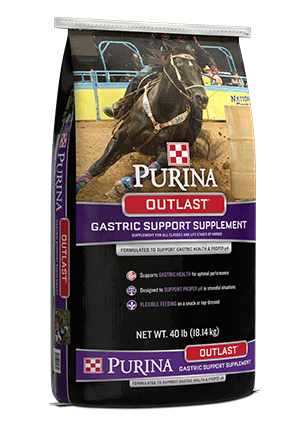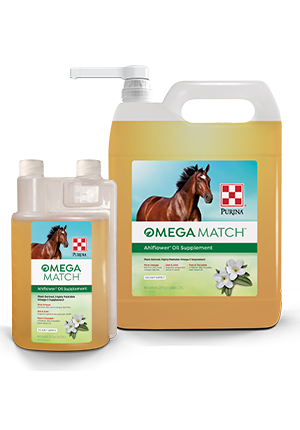
Starches, Sugars, Carbohydrates, Oh My!
Nutrition : General Nutrition
Nutrition : Ingredients & Nutrients
Care : Health Issues
Care : Weight Management

Low sugar and starch. Low carb. Non-structural carbohydrates. Metabolic needs. With the rise in popularity of feeding specialized diets to horses with various metabolic concerns, there seems to be a lot of discussion about these terms. But, what do they mean and how does it affect you, your horse and your horse’s feeding program?
Glucose derived from non-structural carbohydrate digestion serves as an important energy source in the diet of performance horses, providing the horse does not have a dietary carbohydrate sensitivity, such as with insulin resistance or PPID. As long as concentrate meal sizes are appropriate, horses will digest and utilize NSC quite efficiently. As a general rule of thumb, keep concentrate meals to 0.5% bodyweight or less.
However, if a horse consumes an excessive amount of NSC in a meal (such as when a horse gets into the feed room and gorges himself on feed), the small intestine can become overwhelmed and NSC will be delivered to the hindgut. This situation should be avoided at all costs, as excessive NSC in the hindgut can lead to major problems such as hindgut acidosis, colic, and laminitis.
Feed ingredients such as beet pulp and alfalfa meal are lower in NSC, while grain ingredients such as corn, oats, and barley are higher in NSC.
Both non-structural and structural carbohydrates play a vital role in providing energy in a horse’s diet, every horse is unique and it’s important to develop a diet based on your individual horse’s metabolic needs.
Purina® Strategy® Healthy Edge® horse feed is a controlled starch and sugar formula containing fewer calories that can be helpful to optimize body condition while supporting the needs of the performance horse. With the new inclusion of Outlast® Gastric Support Supplement, Strategy® Healthy Edge® horse feed is a great choice to support the needs of horses with a history of gastric concerns.
It’s important to understand that individual horses will have variable responses to feeding of similar diets. A horse’s response to sugar and starch can be impacted by a variety of factors including:
The higher fat and fiber content of Strategy® Healthy Edge® horse feed supplies a controlled number of calories from sources with lower starch and sugar content, which can result in a lower glucose and insulin response to feeding. This creates an appropriate diet for horses that may benefit from this type of concentrate feed.
It is important to understand that individual horses will have variable responses to feedings of similar diets and this response can be impacted by a variety of factors including age, gender, body condition, fitness level, and health.
Purina features a full line of complete feeds and supplements specially formulated to provide low starch and sugar content while meeting the nutrient and calorie requirements for horses at any stage of life.
It is important to work closely with a veterinarian to understand what a horse’s blood test results mean and how diet influences the results.
Every horse is unique and so is their nutrition. Finding the right horse feeding program is paramount to helping your horse perform and feel the best. Find the right feed for your horse with our Feed Finder Tool.
Carbohydrates in horse feeds
There are two primary forms of carbohydrates found in horse feed ingredients:- Non-structural carbohydrates (NSC)
- Structural carbohydrates
Non-structural carbohydrates
Non-structural carbohydrates, or NSC, are the simple sugars and starches present in horse feed ingredients. Simple sugars (such as glucose and fructose) and starches (simple sugars that are attached together as a chain) are readily digested and absorbed in the small intestine. This results in a rise in blood glucose, and subsequently, blood insulin levels.Glucose derived from non-structural carbohydrate digestion serves as an important energy source in the diet of performance horses, providing the horse does not have a dietary carbohydrate sensitivity, such as with insulin resistance or PPID. As long as concentrate meal sizes are appropriate, horses will digest and utilize NSC quite efficiently. As a general rule of thumb, keep concentrate meals to 0.5% bodyweight or less.
However, if a horse consumes an excessive amount of NSC in a meal (such as when a horse gets into the feed room and gorges himself on feed), the small intestine can become overwhelmed and NSC will be delivered to the hindgut. This situation should be avoided at all costs, as excessive NSC in the hindgut can lead to major problems such as hindgut acidosis, colic, and laminitis.
Feed ingredients such as beet pulp and alfalfa meal are lower in NSC, while grain ingredients such as corn, oats, and barley are higher in NSC.
Structural carbohydrates in horse feeds
Structural carbohydrates in horse feeds are found in the cell wall portion of plants and serve as important fiber sources. Structural carbohydrates are prevalent in forages but are also present in higher fiber feed ingredients such as soy hulls and beet pulp. Structural carbohydrates are digested in the horse’s hindgut through microbial fermentation and serve as another important energy source, but they do not result in a rise in blood glucose or insulin.Both non-structural and structural carbohydrates play a vital role in providing energy in a horse’s diet, every horse is unique and it’s important to develop a diet based on your individual horse’s metabolic needs.
Low sugar/starch diets for horses
For horses with carbohydrate sensitivities, managing their sugar and starch intake is critical. Horses with insulin dysregulation, laminitis, PPID or other veterinary-diagnosed conditions need diets with controlled starch and sugar. Diets that have low NSC levels, like WellSolve L/S® or Enrich Plus® horse feed can support normal glucose and insulin responses to feeding.Purina® Strategy® Healthy Edge® horse feed is a controlled starch and sugar formula containing fewer calories that can be helpful to optimize body condition while supporting the needs of the performance horse. With the new inclusion of Outlast® Gastric Support Supplement, Strategy® Healthy Edge® horse feed is a great choice to support the needs of horses with a history of gastric concerns.
It’s important to understand that individual horses will have variable responses to feeding of similar diets. A horse’s response to sugar and starch can be impacted by a variety of factors including:
- Age
- Gender
- Body condition
- Fitness level
- Metabolic status
- Wellness and/or disease
What’s in the bag?
Recent research at the Purina Animal Nutrition Center found that five healthy horses fed a 4 lb meal of Purina® Strategy® Healthy Edge® had a low glucose and insulin response to feeding1. When these values are compared to existing research, they are even more striking as they are lower than those found previously when horses consumed oats2 or even good quality grass hay3, further highlighting the low starch and sugar characteristics of Purina® Strategy® Healthy Edge® horse feed.The higher fat and fiber content of Strategy® Healthy Edge® horse feed supplies a controlled number of calories from sources with lower starch and sugar content, which can result in a lower glucose and insulin response to feeding. This creates an appropriate diet for horses that may benefit from this type of concentrate feed.
It is important to understand that individual horses will have variable responses to feedings of similar diets and this response can be impacted by a variety of factors including age, gender, body condition, fitness level, and health.
Purina features a full line of complete feeds and supplements specially formulated to provide low starch and sugar content while meeting the nutrient and calorie requirements for horses at any stage of life.
It is important to work closely with a veterinarian to understand what a horse’s blood test results mean and how diet influences the results.
Every horse is unique and so is their nutrition. Finding the right horse feeding program is paramount to helping your horse perform and feel the best. Find the right feed for your horse with our Feed Finder Tool.
1HR 272- Strategy and Strategy Healthy Edge Glycemic Index. RD Jacobs and ME Gordon. 2018.
2Glycemic Index of ten common horse feeds. AV Rodiek and CL Stull. Journal of Equine Veterinary Science. May 2007.
3HR 233- Physiological responses of horses to Standlee Timothy Hay. RD Jacobs and ME Gordon. 2018.




